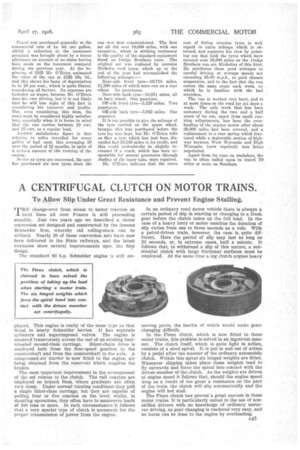A CENTRIFUGAL CLUTCH ON MOTOR TRAINS.
Page 29

If you've noticed an error in this article please click here to report it so we can fix it.
To Allow Slip Under Great Resistance and Prevent Engine Stalling.
TEE change-over from steam to motor traction on local lines all over France is still proceeding steadily. Just two years ago we described a clever conversion set designed and constructed by the famous Schneider firm, whereby old rolling-stock can be utilized. Nearly 20 of these conversion sets have now been delivered to the State railways, and the latest examples show several improvements upoi. the firlt design.
The standard 60 h.p. Schneider engine is still ern • ployed, This engine is really of the same type as that ' fitted to heavy Schneider" lorries.' It has separate 'cylinders and superiamosed valves: The engine is mounted transversely across the end of an existing four
wheeled'second-clash carriage. Silent-chain drive is employed' both from the four-speed gearbox to the countershaft and from the countershaft to the axle. A compressed-air 'starter is now fitted to' the engine, air being obtained from the reservoir width supplies the 'brakes.
The niost important improvement in the arrangement of the set 'relates to the clutch. The rail coaches are employed on branch lines, where gradients are often very steep. Under normal running conditions they pull a single third-class carriage, but they are capable of pulling four or five coaches on the level, whilst, in shunting operations, they often have to manonivre loads of 100 tons or more. In such circumstances it follows that a very special type of clutch is necessary for, the proper transmission of power from the engine.
In an ordinary road motor vehicle there is always a certain period of slip in starting or changing to a fresh gear before the clutch takes up the full load. In the case of a heavy lorry or motor omnibus the duration of slip varies from one to three seconds as a rule. With a petrol-driven train, however, the case is quite different. Here the period of slip may last as long as 20 seconds, or, in extreme cases, half a minute. It follows that, to withstand a slip of this nature, a substantial clutch with large frictional surfaces must be employed. At the same time a big clutch ernes heavy moving parts, the inertia changing difficult.
of whichwould make gear
In the Fieux clutch, which is now fitted to these motor trains, this problem is solved in an ingenious manner. The clutch itself, which is quite light in action, consists of a steel spiral. It is put in and out of action by a pedal after the manner of the ordinary automobile clutch. Within this spiral six hinged weights are fitted. Whenever slipping takes place these weights tend to fly outwards and force the spiral into contact with the driven member of the clutch. As the weights are driven at engine speed it follows that, should' the engine speed drop as a result of too great a• resistance on the part of the train, the clutch will slip automatically and the engine will not stall.
The Fieux clutch has proved a great success in these motor trains, It is particularly suited to the use of non' skilled drivers with no knowledge of ordinary motorcar driving, as gear changing is rendered very easy, and no harm can be done to the engine by overloading.
































